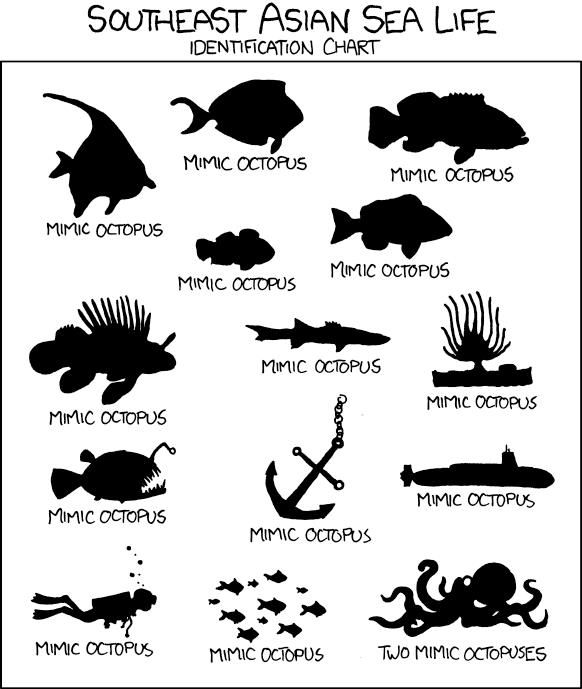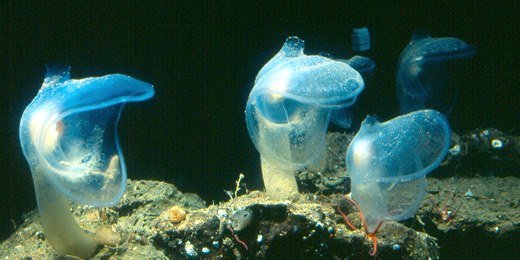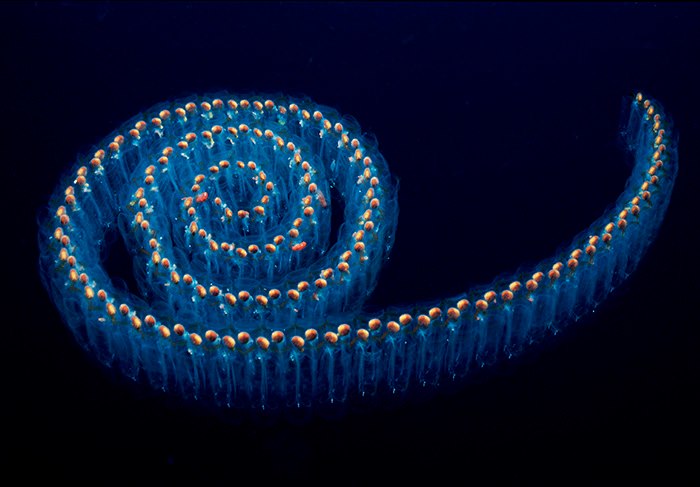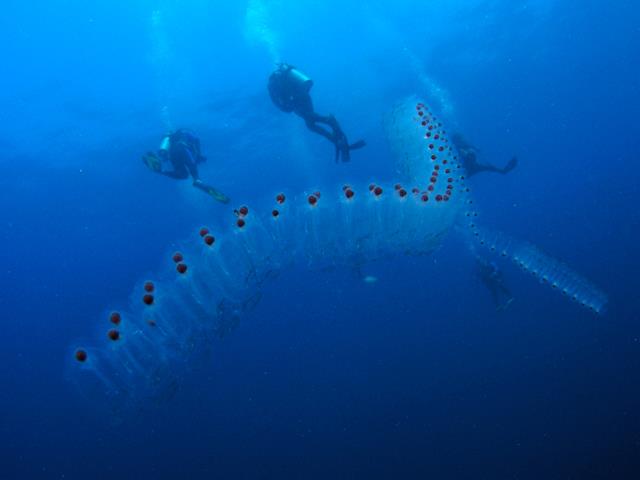It looks like you're using an Ad Blocker.
Please white-list or disable AboveTopSecret.com in your ad-blocking tool.
Thank you.
Some features of ATS will be disabled while you continue to use an ad-blocker.
share:
This video is literally amazing! Watch till the end. It morphs into a two legged turkey type creature.
The Indonesian Mimic Octopus. This fascinating creature was discovered in 1998 off the coast of Sulawesi in Indonesia, the mimic octopus is the first known species to take on the characteristics of multiple species. This octopus is able to copy the physical likeness and movement of more than fifteen different species, including sea snakes, lionfish, flatfish, brittle stars, giant crabs, sea shells, stingrays, jellyfish, sea anemones, mantis, shrimp and chickens.
This animal is so intelligent that it is able to discern which dangerous sea creature to impersonate that will present the greatest threat to its current possible predator. For example, scientists observed that when the octopus was attacked by territorial damselfishes, it mimicked the banded sea snake, a known predator of damselfishes.
Little is known about it.
Amphitretus pelagicus (The Telescope Octopus) can turn transparent at it's will, but is apparently different than the mimic, yet there is dispute as whether the telescope octopus is simply what the mimic sometimes looks like. It's usually found in tropical regions of the Indian and Pacific Oceans. It is transparent, almost colorless and usually has 8 arms.
The Telescope Octopus is an elusive species that has yet to be fully explored. It is a pelagic - or open sea - octopus that can be found in tropical regions of both the Indian and Pacific Ocean.
Interestingly, the Telescope Octopus is transparent and nearly colorless, giving it an eery ghost-like appearance. The Telescope Octopus gets it's common name form the appearance of it's eyes, which are tubular. They are the only species of octopus known to have rotating telescopic eyes.
Little else is known about the biology or behavior of this spooky cephalopod.
Nature is awesome
The Indonesian Mimic Octopus. This fascinating creature was discovered in 1998 off the coast of Sulawesi in Indonesia, the mimic octopus is the first known species to take on the characteristics of multiple species. This octopus is able to copy the physical likeness and movement of more than fifteen different species, including sea snakes, lionfish, flatfish, brittle stars, giant crabs, sea shells, stingrays, jellyfish, sea anemones, mantis, shrimp and chickens.
This animal is so intelligent that it is able to discern which dangerous sea creature to impersonate that will present the greatest threat to its current possible predator. For example, scientists observed that when the octopus was attacked by territorial damselfishes, it mimicked the banded sea snake, a known predator of damselfishes.
Little is known about it.
Amphitretus pelagicus (The Telescope Octopus) can turn transparent at it's will, but is apparently different than the mimic, yet there is dispute as whether the telescope octopus is simply what the mimic sometimes looks like. It's usually found in tropical regions of the Indian and Pacific Oceans. It is transparent, almost colorless and usually has 8 arms.
The Telescope Octopus is an elusive species that has yet to be fully explored. It is a pelagic - or open sea - octopus that can be found in tropical regions of both the Indian and Pacific Ocean.
Interestingly, the Telescope Octopus is transparent and nearly colorless, giving it an eery ghost-like appearance. The Telescope Octopus gets it's common name form the appearance of it's eyes, which are tubular. They are the only species of octopus known to have rotating telescopic eyes.
Little else is known about the biology or behavior of this spooky cephalopod.
Nature is awesome
edit on 3-5-2013 by Gemwolf because: New video link
....well, that qualifies as the craziest thing I've seen today for sure.
Absolutely fascinating - A "Catch Me if You Can" straight from mother nature!
Yet another reason why I long ago stopped saying 'Now I've seen everything'.
Amazing! Thankyou for posting this.
S&F
Amazing! Thankyou for posting this.
S&F
Found out some more useful information about them, a chart from some of the worlds leading oceanographers:


Wow. Where do you think this thing's mimic "templates" come from? Do you think it observes, with its eyes, a shape, say lionfish, then mimics what it
has seen, contorting to lionfish shape? I think not. There is a MAJOR glitch here when the thing mimics
a BIPED land animal! How could it possibly... it is perfectly emulating not only an animal in form, but performing the MECHANIC of walking on land, which is something land dwelling animals took millions of years to evolve, in gravity. Truly, I am amazed. Thanks.
a BIPED land animal! How could it possibly... it is perfectly emulating not only an animal in form, but performing the MECHANIC of walking on land, which is something land dwelling animals took millions of years to evolve, in gravity. Truly, I am amazed. Thanks.
edit on 24-9-2012 by
ecapsretuo because: (no reason given)
Originally posted by ecapsretuo
Wow. Where do you think this thing's mimic "templates" come from? Do you think it observes, with its eyes, a shape, say lionfish, then mimics what it has seen, contorting to lionfish shape? I think not. There is a MAJOR glitch here when the thing mimics
a BIPED land animal! How could it possibly... it is perfectly emulating not only an animal in form, but performing the MECHANIC of walking on land, which is something land dwelling animals took millions of years to evolve, in gravity. Truly, I am amazed. Thanks.edit on 24-9-2012 by ecapsretuo because: (no reason given)
You got me thinking about this so I went looking for examples of fish that walk on the sea floor - and found some. The Mimic Octopus could be mimicking one of these creatures.
the flying gurnard, batfishes of the Ogcocephalidae family, African lungfish
en.wikipedia.org...
There are some species of fish that can "walk" along the sea floor but not on land; one such animal is the flying gurnard (it does not actually fly, and should not be confused with flying fish). The batfishes of the Ogcocephalidae family (not to be confused with Batfish of Ephippidae) are also capable of walking along the sea floor. The African lungfish (P. annectens) can use its fins to "walk" along the bottom of its tank in a manner similar to the way amphibians and land vertebrates use their limbs on land
However, saving the best for last, this Walking Frog Fish seems to resemble the most what this Mimic Octopus was mimicking.
Here is another, Walking Frog Fish. www.youtube.com...
edit on 24-9-2012 by JohnPhoenix because: addition
reply to post by ZeuZZ
i love them all i really like the little one that walks
ill try and find it (edit) alls i can find are ones that walk
when on land but the one i cant find is very small and
only walks
s+f
i love them all i really like the little one that walks
ill try and find it (edit) alls i can find are ones that walk
when on land but the one i cant find is very small and
only walks
s+f
edit on 24/9/2012 by maryhinge because: (no reason given)
However, saving the best for last, this Walking Frog Fish seems to resemble the most what this Mimic Octopus was mimicking.
Good find!
That would explain the bizarre morphology it took. I would assume that during it's evolution one of it's predators found "Walking Frog Fish" poisonous or not very tasty, so left them alone.
Here is wiki on them en.wikipedia.org...
Weird fact, they seem to be really good at camouflaging themselves too. Maybe they don't even exist and they have all been mimic octopi
en.wikipedia.org...
Mimicry and camouflage
A frogfish disguised as an algae-covered stone
The unusual appearance of the frogfish is designed to conceal it from predators and sometimes to mimic a potential meal to its prey. In ethology, the study of animal behavior, this is known as aggressive mimicry. Their unusual shape, color, and skin textures disguise frogfish. Some resemble stones or coral while others imitate sponges, or sea squirts with dark splotches instead of holes. In 2005, a species was discovered, the striated frogfish, that mimics a sea urchin while the sargassumfish is colored to blend in with the surrounding sargassum.[4] Some frogfish are covered with algae or hydrozoa. Their camouflage can be so perfect, that sea slugs have been known to crawl over the fish without recognizing them.
For the scaleless and unprotected frogfish, the camouflage is an important defense against predators. Some frogfish can also inflate themselves, like pufferfish, by sucking in water in a threat display.[7] In aquariums and in nature, frogfish have been observed, when flushed from their hiding spots and clearly visible, to be attacked by clownfish, damselfish, and wrasse, and in aquariums, to be killed.
Many frogfish can change their color. The light colors are generally yellows or yellow-browns while the darker are green, black, or dark red. They usually appear with the lighter color, but the change can last anywhere from a few days to several weeks. It is unknown what triggers the change.
edit on 24-9-2012 by ZeuZZ because: (no reason given)
The human being is the greatest mimic creature ever, being very convincing to itself and others that it is an individual.
Sorry to say.....its true.....You really didn't build that
Sorry to say.....its true.....You really didn't build that
reply to post by ZeuZZ
Wow I can't believe Ive never heard of this beautiful creature before!!
Just what else is down there!!!!
AMAZING. 10/10 Flagged!!
Wow I can't believe Ive never heard of this beautiful creature before!!
Just what else is down there!!!!
AMAZING. 10/10 Flagged!!
Absolutely incredible animal. I was glued to the computer. Thanks so much for posting this. I am off now to google Mimic Octopus
My god. It went from a 6 legged banded white/black octopus to a blue 4-legged octopus, nearly twice the size of the original. It went from looking
like a moving blob of darkness and much to a full-fledged octopus. My favorite is when it buried most of it's tentacles underground to mimic the
banded snake. Now that's smart!
reply to post by JohnPhoenix
That is so cool.
Do you think that maybe we are seeing a stage of evolution where the fish go from being fish to land creatures? Not sure i worded that right but you know what i mean?
CX.
That is so cool.
Do you think that maybe we are seeing a stage of evolution where the fish go from being fish to land creatures? Not sure i worded that right but you know what i mean?
CX.
Originally posted by Kluute
reply to post by ZeuZZ
Wow I can't believe Ive never heard of this beautiful creature before!!
Just what else is down there!!!!
AMAZING. 10/10 Flagged!!
All sorts
It's kind of weird, we probably know more about the surface of other planets than we do about the creatures at the very bottom of the ocean on our own planet.

www.facebook.com...
Predatory tunicates (Megalodicopia hians) are tunicates which live anchored along the deep sea canyon walls and seafloor, waiting for tiny animals to drift or swim into their hood-shaped mouths. Looking something like a cross between a jellyfish and a Venus Flytrap, its mouthlike hood is quick to close when a small animal drifts inside. Once the predatory tunicate catches a meal, it keeps its trap shut until it is ready to eat again. They are known to live in the Monterey Canyon at depths of 200-1,000 m (656-3,281 ft).

www.facebook.com...
Salp chain, Pegea sp., 9 miles off San Diego, California (c) Richard Herrmann
A salp (plural salps; also salpa, plural salpae or salpas) is a barrel-shaped, free-floating tunicate. It moves by contracting, thus pumping water through its gelatinous body. The salp strains the pumped water through its internal feeding filters, feeding on phytoplankton that it sieves out of the water.
Salps are common in equatorial, temperate, and cold seas, where they can be seen at the surface, singly or in long, stringy colonies. The most abundant concentrations of salps are in the Southern Ocean (near Antarctica). Here they sometimes form enormous swarms, often in deep water, and are sometimes even more abundant than krill. Over the last century, while krill populations in the Southern Ocean have declined, salp populations appear to be increasing.

www.facebook.com...
Salps are colonial pelagic tunicates that can grow truly enormous. Sure, they look all slimy and featureless, but tunicates are our closest relative in the invertebrate world. Most chordates can only live as solitary individuals (booooring) but tunicates also live as colonies of genetically identical clones (no other chordate can do that!).
Colonial tunicates pretty much have chordate superpowers. They can absorb and regenerate organs or even entire clones without batting an eye. If broken into fragments, they can reattach, grow, and thrive. Creepily, if a colony comes into contact with either its parent or sibling colony, the colonies will fuse and become one uber-colony.
Creepiest of all, the golden star tunicate (Botryllus schlosseri) has parasitic stem cells. When two colonies fuse, the stem cells battle it out for who gets to control the genes that go into reproduction. Whoever wins gets to pass its genome to the next generation. Whoever loses…well, that’s natural selection.
Tunicates laugh in the face of pollution. If you go to the most godforsaken stinkiest backwater harbor, you’ll probably find tunicates growing there. Many species eat copper antifouling paint for breakfast and wash it down with some tasty fecal bacteria. Harbor-dwelling tunicates travel all over the world on the bottoms of boats and then happily establish themselves in a new home. That’s why most temperate harbors all over the world have similar tunicate species – they’ve managed to migrate. Not bad for something that can’t move on its own.
Tunicates can also kick ass in tropical systems. One Caribbean species, Trididemnum solidum, is overgrowing apparently healthy corals. Trididemnum is the mack truck of tunicates, combining incredibly toxic poisons with spiny spicules to ward off predation. And it’s not even dependent on outside food – it has a symbiotic algae that makes yummy sugars right in its cells.
Additionally, tunicates are noble warriors against climate change. The pelagic tunicates are waging a mighty battle against climate change by exporting all the carbon they can.
Originally posted by CX
reply to post by JohnPhoenix
That is so cool.
Do you think that maybe we are seeing a stage of evolution where the fish go from being fish to land creatures? Not sure i worded that right but you know what i mean?
CX.
Interesting but I don't think so.. not yet anyway. There are creatures like the Hawaiian caterpillar and the Musk Turtle that can both breath on land and underwater. I think if evolution is true in these animals cases ( and we don't know that it is) that they must have evolved these abilities to meet the challenge of living in their environment.It's the same with Humans but to a lesser degree. Many humans of different climates have very different biological processes that help them adapt. Some even have extra glands and some are missing certain glands. Physically on the inside, all humans are not created equal.
This video has been posted on ATS many times over the last few years, but it's always nice to watch again and I'm sure a lot of people who haven't
seen it will get to see it now.
Nature is amazing.
Nature is amazing.
Originally posted by Drezden
This video has been posted on ATS many times over the last few years, but it's always nice to watch again and I'm sure a lot of people who haven't seen it will get to see it now.
It hasn't been posted before, as I made it myself by combining these two best clips we have of it into one and literally uploading today.
But ok, point taken if you have seen it here before and wanted to share that.
new topics
-
Don't cry do Cryo instead
General Chit Chat: 3 minutes ago -
Tariffs all around, Except for ...
Predictions & Prophecies: 2 hours ago -
Gen Flynn's Sister and her cohort blow the whistle on DHS/CBP involvement in child trafficking.
Whistle Blowers and Leaked Documents: 6 hours ago -
Anybody else using Pomodoro time management technique?
General Chit Chat: 9 hours ago -
Bucks County commissioners vote to count illegal ballots in Pennsylvania recount
2024 Elections: 11 hours ago
top topics
-
Trump sues media outlets -- 10 Billion Dollar lawsuit
US Political Madness: 12 hours ago, 24 flags -
Bucks County commissioners vote to count illegal ballots in Pennsylvania recount
2024 Elections: 11 hours ago, 21 flags -
How long till it starts
US Political Madness: 14 hours ago, 17 flags -
USSS Agent Fired for Having Sex In Michelle Obama's Bathroom
Politicians & People: 16 hours ago, 10 flags -
Fired fema employee speaks.
US Political Madness: 13 hours ago, 10 flags -
Gen Flynn's Sister and her cohort blow the whistle on DHS/CBP involvement in child trafficking.
Whistle Blowers and Leaked Documents: 6 hours ago, 8 flags -
Anybody else using Pomodoro time management technique?
General Chit Chat: 9 hours ago, 3 flags -
Tariffs all around, Except for ...
Predictions & Prophecies: 2 hours ago, 1 flags -
Don't cry do Cryo instead
General Chit Chat: 3 minutes ago, 0 flags
active topics
-
Don't cry do Cryo instead
General Chit Chat • 0 • : 727Sky -
Tariffs all around, Except for ...
Predictions & Prophecies • 7 • : FullHeathen -
President-Elect DONALD TRUMP's 2nd-Term Administration Takes Shape.
Political Ideology • 205 • : WeMustCare -
On Nov. 5th 2024 - AMERICANS Prevented the Complete Destruction of America from Within.
2024 Elections • 155 • : WeMustCare -
Mike Tyson returns 11-15-24
World Sports • 53 • : Blueracer -
The Trump effect 6 days after 2024 election
2024 Elections • 143 • : cherokeetroy -
Bucks County commissioners vote to count illegal ballots in Pennsylvania recount
2024 Elections • 21 • : Irishhaf -
60s-70s Psychedelia
Music • 54 • : gort69 -
The art of being offended
Social Issues and Civil Unrest • 49 • : gort69 -
Gen Flynn's Sister and her cohort blow the whistle on DHS/CBP involvement in child trafficking.
Whistle Blowers and Leaked Documents • 6 • : gort69
